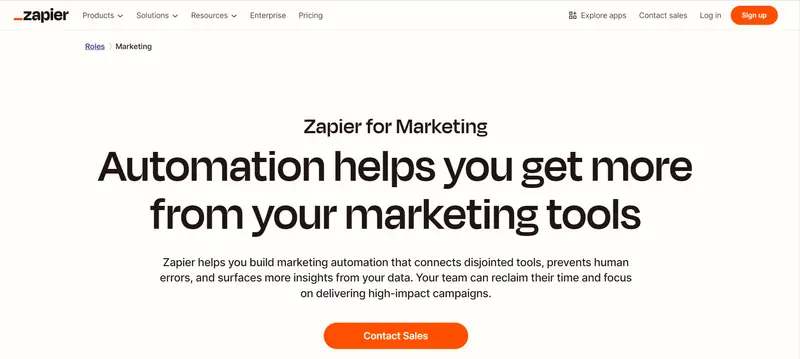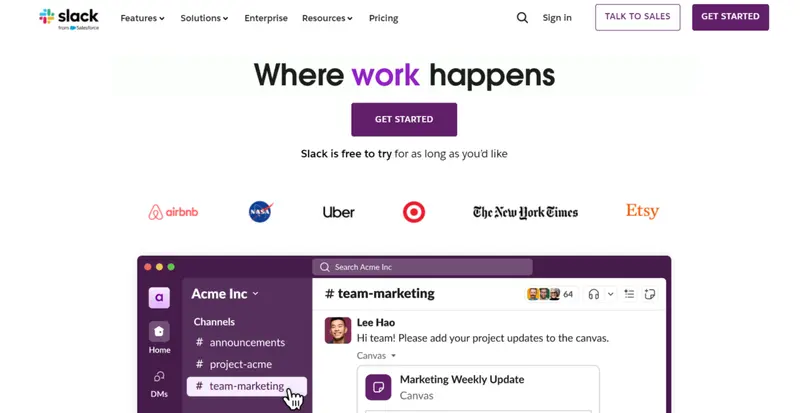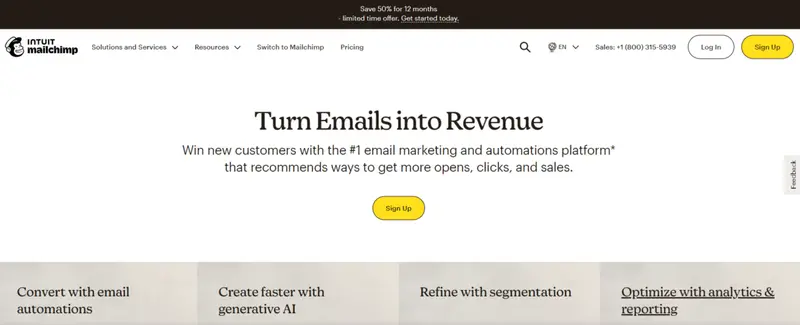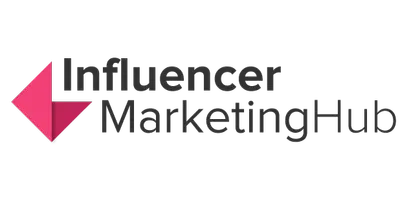While the same consumer will be interested in buying the latest smartphone and signing up for subscription-based services, marketing these two products to the same consumer requires a completely different approach. With the smartphone, you’re essentially planning around a single transaction. SaaS marketing, on the other hand, requires that you engage with customers more long-term. Customer loyalty is taken to a whole new level.
To help you navigate this unique model and its challenges, here’s a highly practical guide that explores advanced frameworks and models. Then, to make it easier to grasp how everything comes together, you can refer to real-life examples of how successful SaaS companies like Slack, Dropbox, and Zapier have implemented these models effectively.
- Intro to SaaS Marketing Strategy
- Advanced Frameworks and Models in SaaS Marketing
- Implementing SaaS Marketing Strategies
- Real-life Examples of SaaS Marketing Strategies Implemented Effectively
- 1. Zapier
- 2. Slack
- 3. Mailchimp
- 4. Intercom
- 5. HubSpot
- 6. Adobe
- TLDR: SaaS Marketing Calls for a Multifaceted Approach
- Frequently Asked Questions
Intro to SaaS Marketing Strategy
Using the SaaS (short for software-as-a-service) business model, companies typically sell monthly subscriptions to generate a recurring revenue stream for use of its software. Before the first monthly subscription starts, users are often given a free trial that typically lasts 7, 14, or 30 days.
Where the target audience is everyday consumers, a freemium business model is often included. In this case, they can use the software free of charge.
There’s a small catch, though. They’ll have access to only limited features. Zoom, Slack, Canva, and Dropbox are just a few examples of SaaS companies successfully implementing the freemium model.
Converting these freemium users into paid users, however, is one of the major unique challenges of SaaS marketing. To help improve this conversion rate, you need to price your product just right — another SaaS marketing challenge.
Then, once you’ve encouraged freemium users to upgrade to one of the paid plans, you still have the hurdle of getting them to renew their subscriptions. Plus, if you’re marketing to the B2B audience, you have the added challenge of having to plan around a long sales cycle as more decision-makers must get involved.
To aid your marketing efforts, consider hiring a dedicated SaaS SEO agency to help set in place the pillars of your business. Once organic visibility kicks in, implementing marketing strategies becomes much more straightforward.
Advanced Frameworks and Models in SaaS Marketing
The following three advanced frameworks and models will help you to navigate these challenges linked to SaaS marketing:
1. AARRR (pirate metrics) framework
The AARRR framework is also called pirate metrics not because it’s a solution to solve piracy but simply because of the acronym’s funny pronunciation. Which brings us to the important point — AARRR is short for:
- Acquisition
- Activation
- Retention
- Revenue
- Referral
You can view it as a type of marketing funnel that outlines the different stages involved in the buyer’s journey.
Using highly targeted inbound marketing and search engine optimization (SEO) strategies that focus on keyword optimization and authoritative backlinks, SaaS companies attract potential users.
After acquisition, attention is turned to the onboarding experience (activation). Slack, for example, makes the initial user engagement highly interactive and informative so that users understand the product’s value from the very first use.
During the retention stage, focus is then shifted to keeping activated users engaged. Email drip campaigns and feature adoption strategies work well. A good example that sets the benchmark is Intercom’s use of educational webinars and targeted messaging based on user behavior.
As mentioned earlier, SaaS marketing is much more about thinking long-term. Instead of using one-off sales as your revenue source, you’ll look at upselling strategies based on data-driven insights.
For example, Zoom implements upselling effectively by offering extra features on paid tiers. This encourages users to upgrade to a better experience at a higher price.
Not only should you get users to sign up for more expensive tiers but also to get them to encourage others to join. Referral programs generally work well.
For example, Dropbox enjoyed a growth of nearly 4,000% in 15 months. It offered extra storage space (a low-cost reward) for both the referrer and the new user to leverage word-of-mouth advertising at scale.
2. Lean startup approach
The lean startup approach focuses on short development cycles. It emphasizes iterative product releases that are based on feedback from real users. This way, SaaS startups can avoid spending too many resources on an unviable or unnecessary feature, minimizing risk.
To see it in practice, you can check out Buffer, one of the leading social media agency software solutions. It has a transparent journey that uses a simple landing page to validate interest. Their team focuses on solving one problem at a time while continuously gathering user insights.

Buffer solution
3. Product-market fit (PMF)
Introduced by Marc Andreessen, an American businessman and software engineer, product-market fit (also called product/market fit) emphasizes the importance of developing a product that meets market needs perfectly. This way, you’ll have enough demand to ensure company growth.
For example, Superhuman, an AI-powered email software for high-performing teams, systematically gathers feedback and segments it into actionable categories. This approach demonstrates how SaaS companies can refine their product to meet exact customer needs.
Implementing SaaS Marketing Strategies
Step 1: Define your audience
Research and understand your target market: Whichever approach you decide to use, you need to have clarity on your target audience. This involves identifying the common characteristics like demographics, pain points, and behaviors of your ideal customers.
Use this information to create detailed buyer personas. These buyer personas will serve as guidance during the decision-making process and help you to customize your marketing strategies so that you can target similar leads.
Whether you’re designing software or marketing it, your goal shouldn’t never be to appease everyone. The reality is that not everyone will love your software. Concentrate only on those with pain points that can be solved by your features.
As Erik Tengen, co-founder and CEO of Oaky, voted the best hotel upsell tech solution for seven consecutive years, puts it in a LinkedIn post, “It’s much easier to win a market if you focus on one segment at a time. Conversely, especially in the early days, if you do not focus, it’s probably impossible to win any segment at all.”
Step 2: Awareness
Attract attention: Use a combination of targeted ads, SEO-optimized content, and social media to make prospective customers aware of your product. The best is to leverage paid strategies with “free” ones like SEO.
For example, B2B SaaS companies can also use trade shows and public speaking as marketing channels. First Page SEO’s data reveals that public speaking can generate an average three-year ROI of over 850%.
At events like these, you’ll typically try to create awareness among decision-makers at the company. However, if your tool is very technical in nature, you might even target your efforts towards engineers. The essence, though, is that you want to target actual individuals rather than the business as a whole.
Then, to measure the effectiveness of these strategies, ensure that you monitor metrics such as site visits and email signups.
Step 3: Engagement
Engage your audience: Once you have the attention of your target audience, provide valuable content that addresses their needs and interests. This could include an email newsletter, blog posts, webinars, and/or downloadable guides.
The goal is to encourage them to interact with your product again after initial sign-up.
Like you’ve done in the previous step, continue to track metrics. For example, if you’re sharing blog posts, you can take it one step further and use heatmaps to track how exactly they interact with your content.
A heatmap visually shows you how visitors move their mouse across a page without clicking, where they scroll, and where they do click. Here’s an example of how Hotjar, one of the most popular heatmap and website optimization tools, track engagement zones on one of their demo pages:

Hotjar Product Demo
Step 4: Desire
Stimulate interest: The work that you’ve put in during the previous three steps are starting to pay off and a relationship between your company and target audience members have started to bloom. They’re busy taking notice and are close to becoming paid subscribers.
Now, to grow their interest level, highlight the benefits and unique selling points of your SaaS product to create a desire for your solution. One way to do that is to create comparisons between your SaaS product and similar solutions that you share on a dedicated landing page or turn into a blog post.
For example, Influencer Marketing Hub has created several blog posts that compare two direct competitors. The Mailchimp vs HubSpot: A Point-by-Point Comparison post is a good example of how you can structure this type of long-form content.
In addition to user interest, you’ll also want to grow your brand’s credibility further. To do this, you can use case studies showcasing real-life applications and testimonials. You can also share user reviews and user-generated content in an email campaign to grow trust.
Whichever type of content you choose, ensure that you add enough visual elements. Aside from grabbing interest, it also makes it easier to skim the text and, in doing so, you can maintain interest for longer. For example, tables work well when writing product comparisons, while video format works better than plain text for sharing testimonials.
Step 5: Conversion
Convert prospects into customers: While SaaS marketing is different to eCommerce marketing, the two approaches share a few common traits like the importance to make checkout as straightforward as possible. Actions like requesting a demo or signing up for a plan should be simple. Basically, it should be the shortest stage of the funnel.
To optimize your website's conversion paths, you’ll pay specific attention to contact pages. Contacting the sales team should be simple. In addition to your main contact page, also add links to your contact page in blog posts and landing pages, for example.
A good example is NinjaPromo’s blog posts. They typically share five calls to action that take readers to a contact page per blot post. This way, visitors never need to scroll too far if they want to take the next step and book an intro call.

NinjaPromo’s blog post
Step 6: Retention
Keep customers engaged: As mentioned earlier, the key differentiator between eCommerce and SaaS marketing is that a SaaS business model depends heavily on loyal customers. The goal is to create recurring revenue (in other words, get subscribers to renew their subscriptions at the end of their contract).
To do this, you need to provide excellent customer support, regular updates, and additional resources. This will also encourage them to use your product more extensively and possibly upgrade to a more expensive plan with more features.
Metrics to watch during this stage include your Net Promoter Score (NPS), customer lifetime value (CLV), and churn rate.
Step 7: Referral
Encourage advocacy: Irrespective of if you’re selling a product, service, or software solution, word-of-mouth advertising remains one of the best strategies. Ensure that you also implement referral programs or incentives to turn satisfied customers into advocates who will refer new users to your service.
As Dropbox’s referral program shared earlier illustrates, it doesn't have to be elaborate. As soon as it becomes too difficult for customers to understand what they need to do in order to get their reward, they’ll lose interest.
PayPal is another example of a SaaS company that’s implemented an effective “double-sided” rewards program. Existing PayPal account holders can earn $10 for every friend that they invite and sign up. Plus, to make it even more attractive, the friend will also get a reward.
This referral program is also a good example of how to add Ts and Cs. In PayPal’s case, the friend needs to send/spend a minimum of $5 within the first 30 days after signing up. They also limit it to $100. It’s simple, but prevents the referral program from becoming too costly.

PayPal Referral Program
Step 8: Optimize and iterate
Analyze and improve: Like your product, your marketing funnel should also undergo changes. Using analytics tools to track the performance of your funnel is an essential step. Continuously test and optimize each stage based on data-driven insights to improve conversion rates and customer retention.
For example, if you’re using social media channels to reach audiences, there are several social media analytics tools that you can use to track audience growth, post impressions, engagement trends, etc. A tool like Buffer, for instance, will even go as far as to identify which times your Instagram posts enjoy the highest reach and which type of post generates the best results.
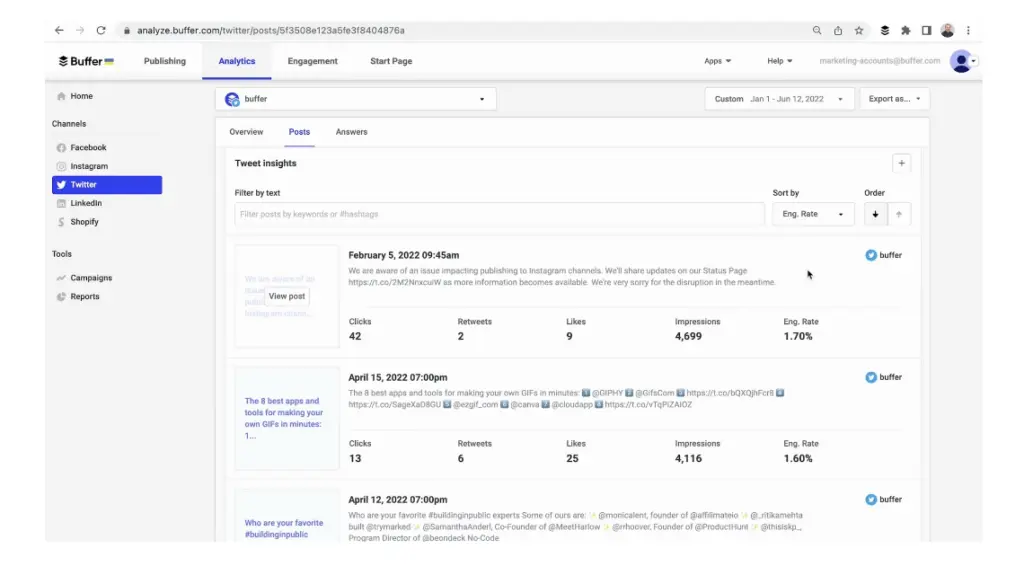
Buffer social media analytics
Step 9: Align sales and marketing
Ensure cohesion: Your sales and marketing team should understand the lifecycle, terms, goals, their role, and, very importantly, the company’s ideal customer profile. This will help prospects move seamlessly through the funnel.
“Smarketing” (the process of aligning marketing and sales processes), though, won’t happen overnight. Know that there will be bumps along. View these as lessons and, like your own marketing strategies, be willing to make iterations.
For example, you’ll find that marketing teams will typically look more at short-term impacts, while sales departments are more focused on long-term wins. Both are important. After all, without interest, there can be no long-term investment.
Create a collaborative environment where both sales and marketing team members have an opportunity to share their insights. Regular meetings are also key. It’s a good idea, for example, to hold weekly or monthly sales meetings so that marketers know how many sales are coming in. You can combine these meetings with shared Google spreadsheets and docs so that different teams can also get real-time updates.
Then, regularly review and adjust your strategies to maintain alignment and ensure that all these stages are covered. And, if you hire a new member along the way, ensure that you onboard them so that everyone remains on the same page.
Real-life Examples of SaaS Marketing Strategies Implemented Effectively
The following examples of SaaS marketing strategies worked well because they leveraged the unique aspects of SaaS, such as the importance of network effects, the need for continuous engagement and education, and the power of community and influencer endorsements. They also demonstrate the effectiveness of a well-rounded marketing strategy that includes SEO, content marketing, influencer partnerships, and a strong focus on user experience.
Lane Scott Jones, the Director of Content at Zapier, reveals that SEO is the primary driver of the business. The team optimizes its website for search engines and create valuable content by: These are some of the main efforts that have helped its blog to attract over 10 millions of visits per month, according to Similarweb, and enable the company to reach a $5 billion valuation in August 2023. As mentioned earlier, Slack makes user engagement interactive and informative from the start to help with activation. The company’s market positioning is another example of how it successfully markets its product. It concentrates on positioning itself as an essential tool for team communication by emphasizing its integration capabilities and ease of use. Clear messaging and user-friendly design let them stand out in a competitive category. Highlighted by Column Five, one of the leading creative agencies, as one of the most inspiring SaaS campaign examples, its “Choose a Better Way to Work” campaign is as clean and simple as its interface itself. It combines print ads with digital formats like videos that organize shapes, illustrating how it can organize chaos (like an email folder) into an orderly system. SaaS marketing still leaves room for creativity as Mailchimp’s branding and promotional videos show. The email marketing platform created a series of promotional assets that used a playful twist of its brand name to help them reach creative small business owners and ultimately become one of the most recognizable brands. Created by Droga5, the campaign went on to win a Cyber Grand Prix at Cannes Lions. For an example of how SaaS brands can use content marketing, you can check out Intercom. Content marketing is a cornerstone for early-stage B2B SaaS startups for search result visibility and audience engagement. Using blogs and podcasting, Intercom could establish itself as a thought leader in customer communication. That said, the company actually rejects the phrase “content marketing”. Instead, they’re driven by their belief that if you concentrate on publishing great content, minimal marketing will be needed. This has led to the birth of a principle – “content, then marketing” – that dictates how its team operates. Basically, it’s about putting readers first and creating content that its target audience would want to read. The result — they’ve grown their blog, which is its main distribution channel, from $1 million to $50 million annual recurring revenue (ARR). Integrating marketing efforts like content creation, SEO and lead nurturing strategies, HubSpot could achieve rapid growth within a short period. It serves as a prime example of a company that uses inbound marketing successfully to attract and engage. It, for example, created a Case Studies Directory, highlighting in-depth case studies that you can filter by industry, HubSpot product, and company size. To make the social proof even more compelling, each case study includes several statistics to quantify the growth achieved and quotes from the customer. Adobe Creative Cloud moved from a perpetual license model to a subscription model. What made this switch highly effective was that it continuously delivered value through product updates and new features to increase its customer lifetime value (CLV). To highlight these tools, Adobe leveraged influencer marketing, a strategy which is less often used by SaaS companies. It partnered with popular designers and photographers to create content using its tools. Aside from showcasing its software’s capabilities, it also leveraged the influencers’ followings to reach a larger audience. Adobe also used influencer marketing to raise awareness for the 2023 Adobe Digital Edge Awards. The campaign generated over 5 million content views and even more paid impressions. 1. Zapier
2. Slack
3. Mailchimp
4. Intercom
5. HubSpot
6. Adobe
TLDR: SaaS Marketing Calls for a Multifaceted Approach
SaaS marketing requires that you combine advanced frameworks like AARRR and principles of lean startup for product development all while paying attention to achieving product-market fit.
SaaS companies like Intercom and Slack have proven that accelerated growth and sustained success are possible. To copy their success, you need to analyze their strategies and use your deep market understanding to create a customer-centric strategy tailored to your target audience and product.
Relentless innovation is also critical. To survive in the competitive SaaS domain, product and marketing strategies need to evolve continuously to solve real problems. Instead of simply getting users to renew their current plan, real growth happens when current users upgrade and new ones join. This is the cycle that you want to find your company in.
Frequently Asked Questions
What should you avoid when marketing a SaaS product?
Common SaaS marketing mistakes include:
- Focusing only on the offer instead of the benefits and value
- Targeting a large market
- Failing to offer a content-rich experience by sharing valuable content like informative blog posts that educate readers
What are examples of SaaS marketing best practices?
- Identify your ideal customer profile (ICP) and buyer personas and target your marketing campaigns
- Create messaging that speaks to the needs of your target audience and reflects your brand voice
- Conduct a channel audit to identify which channels your target audiences use and which existing channels are performing well
- Get your marketing and sales teams together to ensure goals and roles are aligned
- Track your marketing efforts weekly
Which marketing agencies are rated as the best for B2B SaaS marketing?
According to sources from across the web, the following B2B SaaS marketing agencies are regarded as leaders in their field:
- Kalungi
- NinjaPromo
- Huemor
- Inturact
- SmartBug Media
- Bay Leaf Digital
- Cobloom
- SimpleTiger
- Refine Labs
- Hey Digital
- Heinz Marketing
- NoGood
- Single Grain
How can SaaS companies reduce their churn rate?
Churn reduction is critical for long-term sustainability. Effective SaaS churn reduction strategies include:
- Using predictive analytics to identify at-risk customers
- Improving the onboarding experience
- Using proactive engagement strategies that encourage users to interact with your product often
- Offering a generous discounted rate for annual subscriptions
- Asking clients who choose to unsubscribe why they choose to do so

